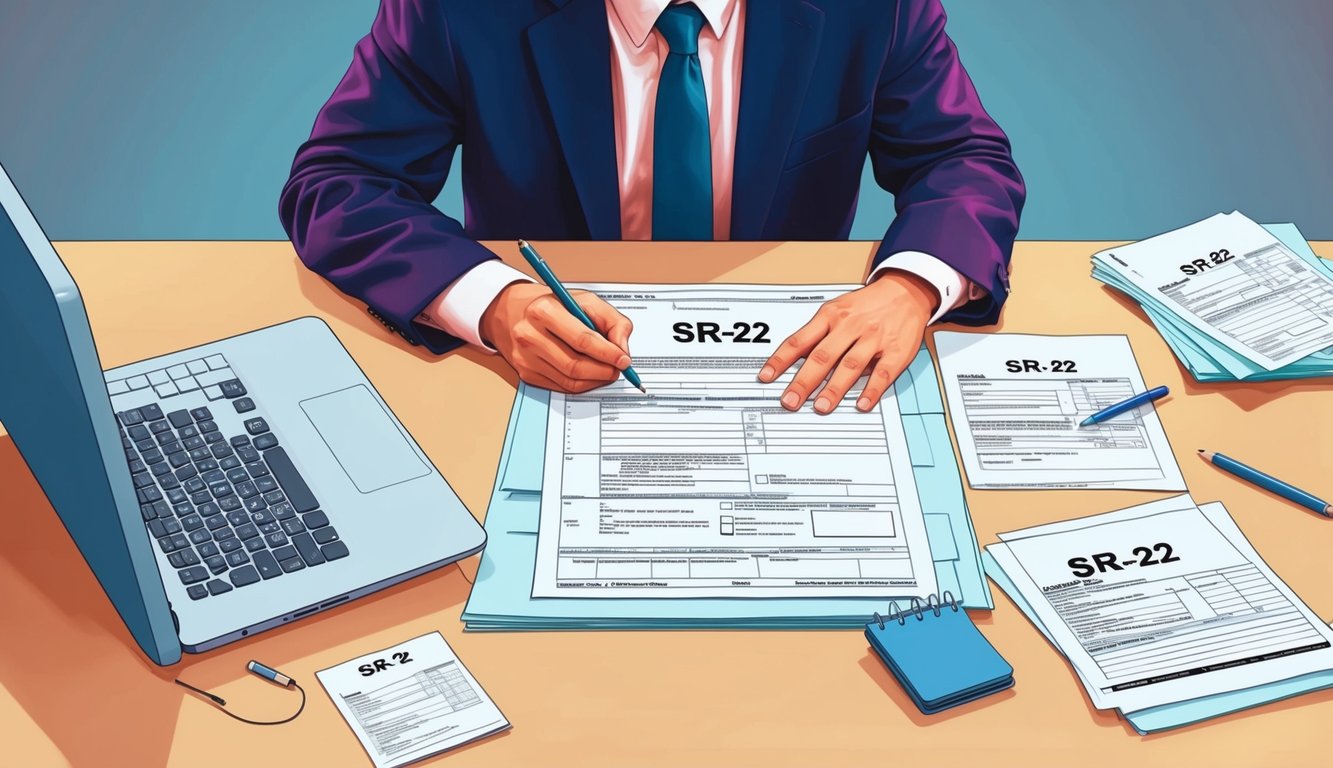Understanding SR-22 Documentation
SR-22 documentation is vital for proving financial responsibility when required by law.
This section covers the definition and purpose of SR-22, comparisons with traditional insurance, and its differences from FR-44 forms.
Definition and Purpose of SR-22
An SR-22 is a document provided by your insurance company to the state.
It confirms that you meet the minimum liability coverage required after certain driving violations.
The primary purpose of the SR-22 is to establish proof of financial responsibility.
When your driving privileges get reinstated, the SR-22 must remain active for a specified period.
This period typically ranges from three to five years, depending on state regulations.
Key points about SR-22 documentation:
- It acts as a Certificate of Financial Responsibility.
- It is often mandated after incidents like DUIs or reckless driving.
- Filing an SR-22 can sometimes increase your insurance premium.
Comparing SR-22 and Traditional Insurance
Traditional insurance policies do not require an SR-22 unless mandated by the state.
In standard scenarios, you pay for coverage without the added process of filing evidence with the DMV.
Most auto insurance policies offer typical documentation reflecting insurance coverage without any special forms.
The SR-22, on the other hand, is specifically designed for those who have had legal or driving issues that prompt state intervention.
Consider these differences:
- Traditional Insurance: No extra documentation; covers usual risks.
- SR-22 Insurance: Requires filing; necessary for reinstatement after certain violations.
Key Differences Between SR-22 and FR-44
While both SR-22 and FR-44 serve similar purposes in ensuring financial responsibility, they cater to different situations and states.
The FR-44 is typically required in Virginia and Florida for higher-risk drivers, such as those convicted of certain offenses.
Unlike the SR-22, the FR-44 mandates higher liability coverages.
Main distinctions include:
- Coverage Amount: FR-44 requires higher limits than the SR-22.
- State Requirements: Each state defines its forms and requirements differently.
- Filing Period: Although both must be maintained for a specific duration, the timeframes and conditions can vary.
Obtaining an SR-22

When you need to obtain an SR-22, understanding the eligibility requirements, how to communicate with your insurance provider, and the filing process with the DMV is essential.
Each step is crucial to ensure that you meet your state’s financial responsibility laws and maintain your driving privileges.
Eligibility and Requirements for SR-22
To be eligible for an SR-22, you typically must have been ordered by the court or your state to provide proof of financial responsibility.
Common scenarios include having a DUI, driving without insurance, or accumulating too many points on your driving record.
Requirements often involve maintaining active car insurance that meets minimum coverage limits.
Your insurance provider must file the SR-22 form on your behalf.
It’s crucial to ensure that your policy remains active because if it lapses, the insurance company will notify the DMV.
This could potentially lead to a suspension of your driving privileges.
Communication with Insurance Providers
Contacting your insurance provider is a critical step in obtaining your SR-22.
First, verify that your current insurance company offers SR-22 services, as not all providers do.
If they do, request the SR-22 form directly.
You may need to provide basic information about your driving history and any legal requirements.
When discussing your needs, ensure clear communication about the implications of the SR-22 on your premium rates.
Be prepared for potential increases, as the presence of an SR-22 may signal higher risk to insurers.
Filing an SR-22 With the DMV
After your insurance provider files the SR-22 form, they will send it to the Department of Motor Vehicles (DMV) in your state.
This filing serves as proof of financial responsibility and is a necessary step to reinstate any suspended driving privileges.
Keep in mind that the DMV will typically notify you when the SR-22 is accepted.
It’s important to follow up, ensuring that your documentation is processed correctly.
Maintain copies of all correspondence for your records, as these may be needed for future reference or disputes regarding your insurance status.
Implications of an SR-22 on Driving Record and Insurance

An SR-22 filing has significant implications for both your driving record and insurance situation.
These effects can influence your insurance rates and coverage, as well as impact the reinstatement of your driving privileges.
Impact on Insurance Coverage and Rates
When you file for an SR-22, you’re typically classified as a high-risk driver.
This status can lead to increased insurance premiums, reflecting the insurer’s assessment of potential risk.
You might notice that auto insurance rates can rise substantially, often by 20% to 50% compared to standard rates.
The SR-22 requirement demonstrates a commitment to maintaining the minimum liability insurance mandated by your state.
Insurers may adjust your coverage options based on your driving history.
To manage costs, consider shopping around for quotes from different providers, as rates can vary significantly.
Duration of SR-22 Requirements
The duration of your SR-22 requirement can vary based on state regulations and the specifics of your driving violations.
Generally, you may need to maintain the SR-22 for three years, but some situations could extend this period.
If you fail to maintain the SR-22 during this time, your insurance company is obligated to notify the state.
This could lead to suspensions or additional penalties.
It’s essential to remain compliant to avoid further complications with your driving record.
SR-22 and License Reinstatement
Obtaining an SR-22 is often a prerequisite for license reinstatement after a suspension.
This filing serves as proof that you carry the required liability insurance.
Reinstatement fees vary by state and can be an added financial burden.
If your license is suspended due to DUI or serious violations, you may also be required to take defensive driving courses to satisfy the conditions for reinstatement.
Keeping your SR-22 current is crucial during this process.
Failing to do so can result in further legal issues and extended periods without driving privileges.
Compliance and Penalties

Understanding compliance requirements for SR-22 documentation is crucial for maintaining your driving privileges.
Non-compliance can lead to various penalties, including financial implications and loss of your driving rights.
Maintaining Continuous Coverage
To comply with SR-22 regulations, you must maintain continuous auto insurance coverage.
This means you cannot have any lapses in your policy, as even a single day without coverage can result in penalties.
Most states mandate a minimum liability coverage level, which you need to meet or exceed throughout the SR-22 filing period.
If you change insurance providers, notify your new company about your SR-22 requirement.
They will then file the necessary documentation on your behalf.
Failing to maintain continuous coverage can lead to a suspended or revoked license.
It can also incur additional fees for reinstatement that can vary widely by state.
Consequences of Non-Compliance
Non-compliance with SR-22 can have serious repercussions.
One immediate consequence is the loss of your driving privileges.
If pulled over while driving with a suspended license, you may face significant fines or legal penalties.
Additionally, penalties for failing to file the SR-22 can include reinstatement fees that can reach up to $250 in some states.
Driving without the proper documentation can further complicate your situation.
If you’re in need of a vehicle but do not own one, consider non-owner SR-22 insurance to comply without a personal vehicle.
This type of policy still adheres to your state’s insurance requirements while protecting you in various driving scenarios.
Legal and Safety Considerations

Navigating the responsibilities related to SR-22 documentation involves understanding the legal implications of traffic violations, the potential benefits of defensive driving courses, and how these elements promote public safety.
Each of these areas plays a critical role in ensuring compliance with state regulations while also aiming to reduce future incidents on the road.
Legal Ramifications of Traffic Violations
Traffic violations, such as DUI or DWI, can lead to serious legal consequences including fines, license suspension, and the requirement to file an SR-22.
When you are deemed at fault in an accident, you may face increased insurance premiums and potential court-ordered child support if financial obligations stem from the incident.
Failing to comply with state requirements can prolong the SR-22 mandate and exacerbate legal issues.
The penalties connected to traffic violations can vary significantly by state, making it essential for you to understand the specific laws that apply to your situation.
The Role of Defensive Driving Courses
Participating in a defensive driving course can offer several advantages.
Many states allow the completion of such courses to mitigate points on your driving record or reduce insurance premiums.
These courses educate you on safe driving practices, helping to avoid future violations and enhancing your skills behind the wheel.
Furthermore, proof of completion may fulfill some state requirements for SR-22 filing.
This signals to your insurance provider and the authorities that you are taking proactive steps to improve your driving behavior.
Promoting Public Safety
The relationship between safe driving practices and public safety cannot be overstated.
When you engage in defensive driving, you contribute to a broader societal goal of reducing traffic incidents.
This proactive approach helps lower the chances of accidents, including those resulting from DUI or DWI offenses.
Additionally, educating drivers about the implications of traffic violations fosters a culture of responsibility on the roads.
Adhering to regulations not only protects your interests but also secures the safety of everyone who shares the road.
This reinforces a collective commitment to safer driving habits.
Frequently Asked Questions

This section addresses common inquiries regarding SR22 documentation.
Understanding these elements is crucial for navigating your responsibilities and the implications they have on your insurance coverage.
What is SR22 insurance and when is it required?
SR22 insurance is not a type of insurance but a certificate proving your financial responsibility.
It is typically required after serious violations such as DUI, reckless driving, or accumulating too many points on your driving record.
Your state’s Department of Motor Vehicles (DMV) mandates this documentation to reinstate your driving privileges.
How does an SR22 certification affect my car insurance premiums?
Obtaining an SR22 can elevate your car insurance premiums.
Insurance providers see you as a higher-risk driver due to past violations.
The actual increase varies by state and insurer, but it often results in substantially higher costs for coverage.
What are the steps to file an SR22 form?
To file an SR22 form, follow these steps:
- Contact your insurer: Notify them that you need to file an SR22.
- Provide necessary information: Your insurer will require details about your driving history and the violations.
- Pay any fees: There could be associated costs for filing.
- Monitor the filing: Ensure your insurer sends the SR22 to the DMV as required.
How long must one maintain an SR22 filing in various states?
The duration for maintaining an SR22 filing varies by state.
Generally, you must keep it for 1 to 3 years.
States like California typically require 3 years, while others might have different time frames based on the nature of your offense.
Can I obtain SR22 insurance through any auto insurance provider?
Not all auto insurance companies offer SR22 filings.
You need to confirm with your provider whether they can issue this certificate.
If your current insurer does not offer it, you may need to seek coverage from a different company that specializes in high-risk insurance.
What are the common reasons a driver might be required to file an SR22?
Drivers often need to file an SR22 due to a range of violations.
Common reasons include:
- Driving under the influence (DUI)
- Serious or repeated traffic offenses
- Driving without insurance
- Accumulating excessive points on your driving record






